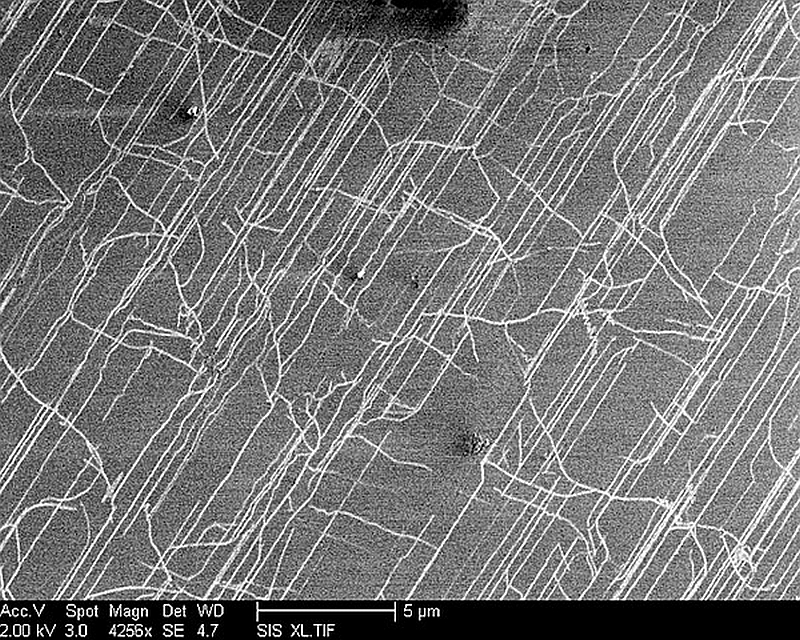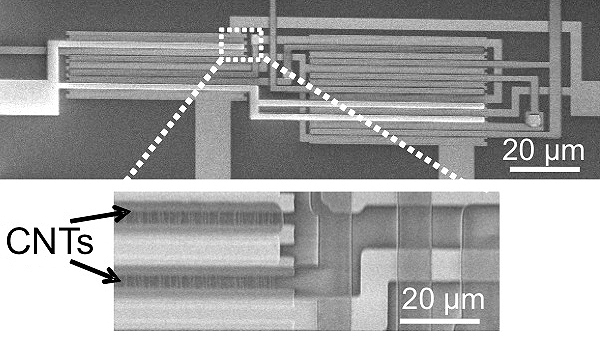Carbon Nanotubes Enable Highly Energy-Efficient Computing

This Behind the Scenes article was provided to LiveScience in partnership with the National Science Foundation.
Miniaturization is the principal driver of the semiconductor industry, and the most significant challenge to continued miniaturization of electronic systems is energy efficiency.
"As we approach the ultimate limits of Moore’s Law, however, silicon will have to be replaced in order to miniaturize further," said Jeffrey Bokor, of Lawrence Berkeley National Laboratory and the University of California, Berkeley.
To this end, carbon nanotubes are a significant departure from traditional silicon technologies and a promising path to solving the challenge of energy efficiency in computer circuits. Carbon nanotubes are cylindrical nanostructures of carbon with exceptional electrical, thermal and mechanical properties. Nanotube circuits could provide an order-of-magnitude improvement in energy efficiency over traditional silicon technology.
When the first rudimentary nanotube transistors were demonstrated in 1998, researchers imagined a new age of highly efficient, advanced computing electronics. That promise, however, has yet to be realized due to substantial material imperfections inherent to nanotubes that have left engineers wondering whether carbon nanotubes will ever prove viable.
Over the last few years, however, a team of Stanford engineering professors, doctoral students, undergraduates and high-school interns, led by professors Subhasish Mitra and H.-S. Philip Wong, took on the challenge. Their work has produced a series of breakthroughs that represent the most advanced computing and storage elements yet created using carbon nanotubes.
Stubborn challenges
Sign up for the Live Science daily newsletter now
Get the world’s most fascinating discoveries delivered straight to your inbox.

These high-quality, robust nanotube circuits are immune to the stubborn and crippling material flaws that have stumped researchers for over a decade, a difficult hurdle that has prevented the wider adoption of nanotube circuits in industry. The advance represents a major milestone toward what researchers call "very-large scale integrated systems" based on nanotubes.
"The first carbon nanotubes wowed the research community with their exceptional electrical, thermal and mechanical properties over a decade ago, but this recent work at Stanford has provided the first glimpse of their viability to complement silicon CMOS transistors," said Larry Pileggi, professor of electrical and computer engineering at Carnegie Mellon University.
While there have been significant accomplishments in carbon nanotube circuits over the years, they have come mostly at the single-nanotube level.
At least two major barriers remain before carbon nanotubes can be harnessed into technologies of practical impact. First, processing must achieve near-perfect alignment of nanotubes. Misaligned nanotubes introduce detrimental, stray, conducting paths and faulty functionality into the circuits. Second, engineers must eliminate metallic carbon nanotubes (as opposed to more desirable semiconducting carbon nanotubes) from the circuits. Metallic carbon nanotubes lead to short circuits, excessive power leakage and susceptibility to circuit noise. No carbon nanotube synthesis technique has yet produced exclusively semiconducting nanotubes.
Circumventing barriers

Realizing that better processes alone will never overcome these imperfections, the Stanford engineers circumvented the barriers using a unique imperfection-immune design. They have produced the first full-wafer-scale digital logic structures based on carbon nanotubes that are unaffected by misaligned and mis-positioned nanotubes. Additionally, they have addressed the challenges of metallic carbon nanotubes with the invention of a technique to remove these undesirable elements from their circuits.
"Carbon nanotube transistors are attractive for many reasons as a basis for dense, energy efficient integrated circuits in the future," said Supratik Guha, director of the Physical Sciences Department at the IBM Thomas J. Watson Research Center. "But, being borne out of chemistry, they come with unique challenges as we try to adapt them into microelectronics for the first time. Chief among them is variability in their placement and their electrical properties. The Stanford work, which looks at designing circuits that take into consideration such variability, is therefore an extremely important step in the right direction."
The Stanford design approach has two striking features in that it sacrifices virtually none of carbon nanotubes’ energy efficiency and also is compatible with existing fabrication methods and infrastructure, pushing the technology a significant step toward to commercialization.
"This is very interesting and creative work. While there are many difficult challenges ahead, the work of Wong and Mitra makes good progress at solving some of these challenges," said Bokor.
"This transformative research is made all the more promising by the fact that it can co-exist with today’s mainstream silicon technologies, and leverage today’s manufacturing and system design infrastructure, providing the critical feature of economic viability," said Betsy Weitzman of the Focus Center Research Program at the Semiconductor Research Corporation.
Demonstrating possibilities

The engineers next demonstrated the possibilities of their techniques by creating the essential components of digital integrated systems: Arithmetic circuits and sequential storage, as well as the first monolithic 3D integrated circuits with extreme levels of integration.
The Stanford team’s work was featured recently as an invited paper at the prestigious International Electron Devices Meeting as well as a "keynote paper" in the April 2012 issue of the prestigious journal IEEE Transactions on Computer-Aided Design of Integrated Circuits and Systems.
"Many researchers assumed that the way to live with imperfections in carbon nanotube manufacturing was through expensive fault-tolerance techniques. Through clever insights, Mitra and Wong have shown otherwise. Their inexpensive and practical methods can significantly improve carbon nanotube circuit robustness, and go a long way toward making carbon nanotube circuits viable," said Sachin S. Sapatnekar, editor-in-chief of the journal. "I anticipate high reader interest in the paper."
Editor's Note:The researchers depicted in Behind the Scenes articles have been supported by the National Science Foundation, the federal agency charged with funding basic research and education across all fields of science and engineering. Any opinions, findings, and conclusions or recommendations expressed in this material are those of the author and do not necessarily reflect the views of the National Science Foundation. See the Behind the Scenes Archive.










